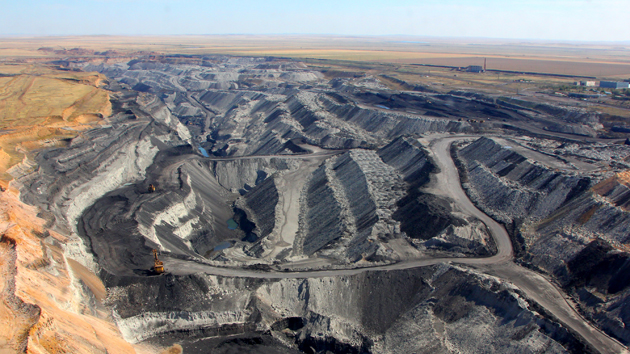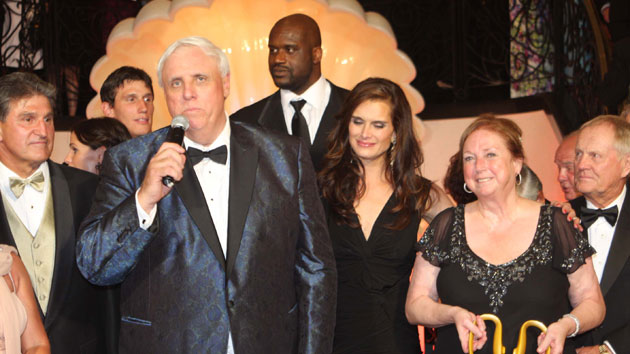The people of the Kentucky and West Virginia borderland, where Don Blankenship’s family has lived for generations, have always clustered, out of tradition and necessity, along river valleys and in low-lying hollows amid the nubby Appalachian peaks. The winding roads there, crumbling under the weight of overloaded Mack trucks, are lined with trailers like the one Blankenship grew up in, many with “Friend of Coal” placards in their windows. But at the peak of his 18-year reign as the CEO of coal giant Massey Energy—as if in a symbolic nod to his rise from hardscrabble roots—Blankenship erected a four-story villa that evoked a fairy-tale castle on a Kentucky mountaintop. It was a short helicopter ride from his primary home, a gated estate on the other side of the Tug Fork River. From a white tower atop his Massey-owned mountain retreat, Blankenship could look out on the coal yards and misty hollows of West Virginia’s Mingo County like a king surveying his domain.
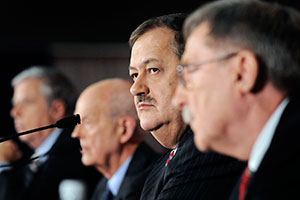
Blankenship earned his way to this summit by reducing many of the nearby mountaintops to heaps of gravel and harvesting the bituminous seams inside them to nearly triple his company’s revenue. Heavyset and balding, with a slug of a mustache and anthracite eyes, he was a harsh taskmaster whose cutthroat management style transformed what was once a modest family business into the region’s largest coal producer. In the process, he rose from a small-town accountant to a political heavyweight who dined at the White House and rocked out with Ted Nugent.
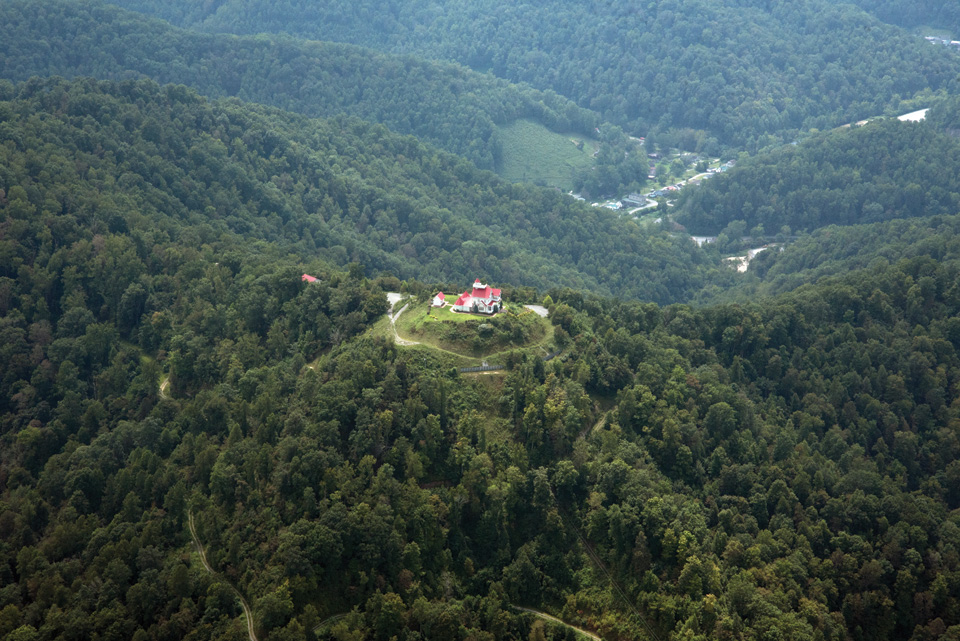
Blankenship cultivated an image as a Mingo County son made good—a good ol’ boy who ran a multibillion-dollar company from a double-wide trailer. And he saw himself as a heroic figure who brought jobs to the depressed enclaves of his native West Virginia. But with his gaze fixed on the bottom line, Blankenship crushed the mine workers union that was baptized in his backyard. Voluminous court records and government investigations show that he presided over a company that padded its profits by running some of the most dangerous workplaces in the country. Massey polluted the waterways that had sustained Blankenship’s forebears, rained coal dust on the schoolyards where his miners’ children played, and subjected the men he grew up with in southern West Virginia to unsafe working conditions.
A mascot of the coal industry’s worst excesses, Blankenship pumped millions of dollars into West Virginia’s political system to promote an anti-regulatory agenda and curry favor with state lawmakers and officials. But Massey’s pursuit of profits at any cost ultimately proved to be Blankenship’s downfall. When, on April 5, 2010, an explosion at Massey’s Upper Big Branch mine killed 29 workers—the worst mining disaster in the United States in 40 years—prosecutors began slowly building a case against the powerful mogul.
Last November, four years after Blankenship left Massey and the company was bought for $8.5 billion by Virginia-based coal company Alpha Natural Resources, a federal grand jury indicted him for allegedly conspiring to commit mine safety violations, conspiring to cover up those violations, and providing false statements about his company’s safety record. He could face more than 30 years behind bars.
Blankenship, who has pleaded not guilty, is slated to go on trial on October 1. For the better part of the past year, he’s been restricted by a judge’s order to the eastern Kentucky and southern West Virginia counties where he has spent most of his life—a prisoner among those he’s allegedly wronged. The trial’s timing is foreboding: Dwindling reserves and cheap natural gas, with a nudge from new environmental regulations imposed by the Obama administration, have tightened the noose around Appalachian coal. In August, Alpha Natural Resources filed for bankruptcy. Blankenship’s prosecution could be a canary for something bigger—the death knell of an industry that has both taken lives and sustained them for as long as anybody in these parts can remember.
The irony is that, even at the nadir of Blankenship’s power, his ideology is ascendant. He transformed West Virginia not just physically (entire towns have been wiped out by Massey’s footprint), but politically. Now, by playing off fears of creeping government involvement, the coal industry has strengthened its grip on state politics. Lawmakers friendly to the industry, with financial support from Blankenship, have won sweeping victories at the ballot box and used their mandate to roll back health and safety regulations while trumpeting the survival-of-the-fittest capitalism that was Blankenship’s gospel. The man on the mountaintop may have fallen, but the widespread impact of his legacy shows no signs of diminishing.
“The most hated man in Mingo County,” as Blankenship once described himself, was born in Stopover, a hollow on the Kentucky side of the Tug Fork River where mine blasts periodically rattle dishes. The youngest of four kids, he is a McCoy on his mother’s side, making him a distant relative of the clan that sparred with the Hatfields after the Civil War. The Tug Valley is filled with McCoys. It’s also filled with Hatfields and, for that matter, Blankenships. The ties that bind communities together in this region reach back over centuries. That helps explain Blankenship’s profound affection for this place—and why he stayed even as he climbed the corporate ladder of a Richmond-based company. It also makes the scorched-earth tactics that fueled his rise all the more difficult to reconcile.
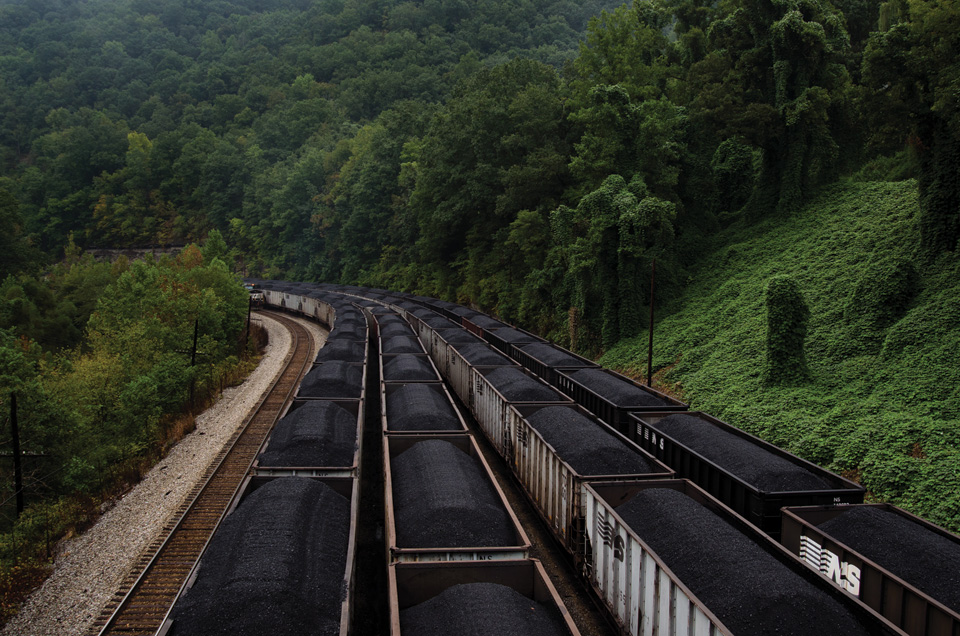
Before Blankenship started school, his family moved across the river to the West Virginia town of Delorme, where he and his siblings lived without indoor plumbing in a camper adjoining their mother’s gas station along the railroad tracks. As a child, Blankenship honed his skill with numbers by managing the books for the family business; for entertainment, he watched bar fights from the roof of a nearby barber shop. He grew up among the working poor and learned to admire those, like his mother, who clawed their way up without government assistance. Not that the cash-strapped state had much assistance to provide. So acute was the isolation and sense of neglect in Mingo that when the town of Vulcan was cut off from the rest of the state by a bridge collapse in the 1970s, it appealed to the Soviet Union for aid.
To pay his way through college at Marshall University, where he studied accounting, Blankenship joined the United Mine Workers of America (UMWA) and worked at a mine during the summers. He “was basically forced to leave the area” after college, he has said, because of the lack of job opportunities, but in 1982 he returned to manage the books at Rawl Sales & Processing Co., a Massey subsidiary that operated a mine across the street from Blankenship’s old high school in the town of Matewan.
Two things happened the year Blankenship started at Rawl Sales that would have a profound impact on him. After decades of turmoil for mine workers that culminated with the conviction of a UMWA boss for orchestrating the assassination of a rival, a reform candidate, Richard Trumka, was elected to lead the union with a promise to take on any company that refused to sign its industry-wide contract. The second was the distribution of a 27-page document called the Massey Doctrine by the company’s then-president, E. Morgan Massey. Massey’s “value system,” according to one section, was based on the premise that “self comes before society at large,” and the doctrine outlined strategies to squeeze the maximum return out of the company’s mines and effectively break the control of unions.
Whenever possible, Massey contracted out the operation of its properties, shielding itself from the requirement to pay pensions or workers’ compensation by leaving a small local operator with the tab for these benefits. Although it operated as a centralized conglomerate, Massey insisted on treating its subsidiaries as independent companies, in order to force the UMWA to go through the laborious process of negotiating with each of them.
In the fall of 1984, when Massey refused to negotiate with the UMWA on behalf of all its properties, Trumka ordered a strike targeting a handful of the company’s mines. Rawl Sales, where Blankenship had been promoted to president, was ground zero. At first, management handed out coffee to the picketers and even offered diesel fuel for their outdoor stoves when temperatures dropped. But a few months in, Rawl Sales hired nonunion replacement workers and brought in a private security company that fortified the mine with barbed wire, steel walls, and attack dogs. Massey, not for the last time, used the legal system to apply pressure to its adversaries. A Mingo County judge named Spike Maynard, who would become a lifelong friend of Blankenship, issued an injunction restricting UMWA picketing. When the union defied the order, Maynard fined it $200,000.
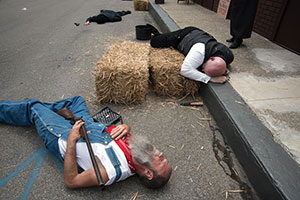
The arrival of armed guards stirred up long-simmering tensions in coal country and evoked the industry’s bloody past. The old post office down the road from Rawl Sales is still pocked with bullet holes from a 1920 gunfight between union organizers and detectives hired by a local mining company that left 11 people dead. (Mary Harris “Mother” Jones, the namesake of this magazine, was involved in the organizing drive that preceded the armed standoff.) That incident, known as the Matewan Massacre, branded the county with a new nickname: Bloody Mingo. And it precipitated an even larger clash a year later at Blair Mountain, one county over, where anti-union forces dropped bombs from airplanes to quell a rebellion of 10,000 miners. More than 100 people died in the battle, and UMWA leaders were tried for treason by the state. (Massey later sought to revoke the battlefield’s historic designation so it could build a surface mine—typically created by leveling a mountaintop to get at the coal, instead of tunneling in.)
Once again, Mingo County became a conflict zone. A union chief’s bedroom was shot up while his children were home. Blankenship accused the union of spraying his office with bullets and forcing him to sleep in safe houses. Snipers prowled winding mountain roads, taking potshots at nonunion truck drivers—even killing one. Dynamite was placed in trees and detonated to knock down power lines at coal processing plants. According to one newspaper account, the superintendent of another Massey subsidiary was “pulled from his car, beaten and thrown into the river by a group of masked men.” Picketers smashed hundreds of Massey vehicles. (Trumka denies any union wrongdoing.) The company deployed coal trucks to ram cars that attempted to block the two-lane road connecting the mine to the rest of the county. One retired miner who patrolled the entrance to Rawl Sales with a slingshot told me that Blankenship tried to recruit him to spy on the union. Several others offered an unusual allegation—that private security guards mooned the picketers to provoke violent responses.
“It was very, very obvious from the first part that [Blankenship] cared about one thing and one thing only, and that was the dollar, and it was clear that he worshipped at the altar of greed and dollars, and he wouldn’t let anything get in the way,” says Trumka, who is now the president of the AFL-CIO, the nation’s largest federation of trade unions. “He claimed to be a local boy—that he cared about the locality and wanted to do something to help people. But all of his actions speak the opposite way.”
The violence instilled a sense of victimhood that stuck with Blankenship. “I’m ready to be killed for this,” he told the Washington Post. “I had uncles and cousins who fought in the world wars. We don’t view it as any different. The [UMWA] is trying to take away our freedom.” He believed the union’s actions amounted to terrorism and reflected a backward worldview that he was trying to stamp out. “What you have to accept in a capitalist society, generally, is that…it’s like a jungle, where a jungle is survival of the fittest,” he said in another interview. “Unions, communities, people—everybody’s going to have to learn to accept that in the United States you have a capitalist society, and that capitalism from a business viewpoint is survival of the most productive.”
After 13 months, the union miners returned to work, but the strike marked the beginning of the end for the UMWA in Mingo County. Today, the Matewan chapter has no active miners among its 850 members. Blankenship, meanwhile, emerged from his mine war radicalized, and determined to mold coal country along his ideological lines. Over the next two decades, as he pushed his workers to the brink, busted unions, and pooh-poohed complaints over Massey’s health and safety record, he returned again and again to that strike—and “the ignorance and evilness of the United Mine Workers”—in speeches and interviews. “I’ve been the subject of their threats and their violence,” he told West Virginia’s leading business newspaper, the State Journal, in 2002. “I have a television in my office with a bullet hole in it that I feel pretty comfortable came from a union member. The problem that the union has is that they have a criteria for employment that does not change, and they live in a world that changes.”
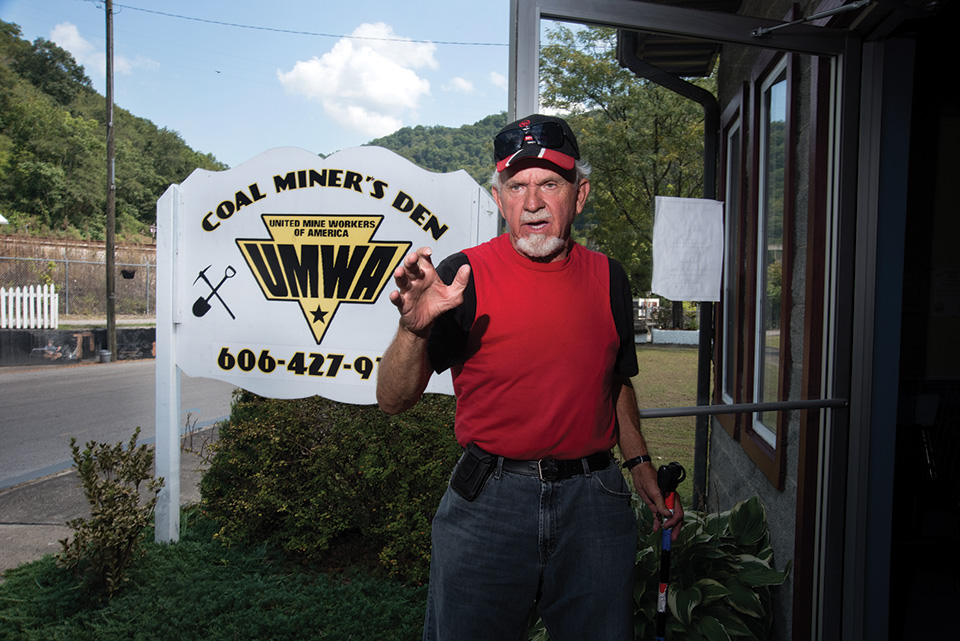
If the rawl sales strike hastened the decline of the UMWA, it marked the ascendance of Blankenship, establishing him as an unflinching operator who could squeeze profits out of his property even in the most adverse conditions. In 1992, when E. Morgan Massey retired, Blankenship was anointed the company’s CEO. Under his leadership, Massey cornered a growing share of a shrinking market by hoovering up coal reserves (2.2 billion tons of them) and using its size to bring smaller companies to heel. Its tactics against Harman Mining, a Virginia-based, unionized coal processing outfit, were emblematic. In 1997, Massey bought Harman’s primary distributor and then effectively starved Harman into submission by refusing to honor their contract. With no outlet for its supply, Harman went belly-up. Its president, Hugh Caperton, sued Massey for breach of contract and eventually won a $50 million judgment, but it was years before he ever saw a cent.
Blankenship used similar methods when it came to the union. Rather than negotiate with the local chapter at a given Massey subsidiary when a contract ran out, he would shut down the operation for a year and then reopen it under a different name, forcing the union to start organizing from scratch if it wanted a presence there. Blankenship went so far as to send miners on paid vacations to Dollywood, to dissuade them from organizing. According to Michael Shnayerson’s book about the Massey empire, Coal River, some miners who’d been waffling on unionizing conspicuously began arriving to work in new cars. Massey opened its first fully nonunion facility in 1981; by 2002, just 200 of its 4,500 employees had UMWA cards.
Massey acquired an exceptional reputation in a brutish industry. Blankenship placed relentless pressure on his mine supervisors to produce, and they in turn leaned heavily on their miners to work impossibly long hours, in some cases without breaks for rest or sustenance. Expected to put in overtime whenever asked, some miners only received one day off in a month. A former Massey miner told me he once brought the same sandwich to work three shifts in a row without ever being allowed to take his allotted dinner break. When another miner complained about skipping meals, his manager told him to suck on a peppermint.
As a profession, mining has grown much less hazardous than it was in the Bloody Mingo days, when a West Virginia coal worker was as likely as an American doughboy in France to die on the job. Yet the various ways miners can be killed or maimed has changed little over the centuries. A fire could break out. A wall or roof could collapse. A piece of equipment could fall, crushing anyone who stands below. A flood could drown workers or isolate them in a pocket of the mine. They could suffocate from a mix of poisonous gases known as “afterdamp.” If none of these kill them, black lung might. But the biggest danger inside an underground mine—the cause of virtually all the industry’s deadliest accidents—is an explosion. Coal dust is combustible, as is the methane that collects in mines, and if not diligently swept and ventilated, they can unite to form a spectacular blast that triggers any of the above hazards. The core function of mine safety legislation, therefore, has been to prevent mines from blowing up.
But safety laws have always lagged behind the latest accident. The federal government didn’t create an agency to regulate mines (what is now the Mine Safety and Health Administration, or MSHA) until 1910, after 362 people died in Monongah, West Virginia. The agency had no code of regulations until after 111 miners died in Centralia, Illinois, in 1947. It didn’t conduct annual inspections until an explosion killed another 119 Illinois miners in 1951. And it didn’t impose monetary penalties for violations until a 1968 blast in Farmington, West Virginia, killed 78 miners.
Well before the Upper Big Branch disaster, there were signs that Massey, despite its avowed “safety first” commitment, was fostering a culture of anything but. A 1993 investigation by Paul Nyden, a reporter at the Charleston Gazette who first exposed the existence of the Massey Doctrine, revealed that Massey’s contractors routinely avoided paying out workers’ compensation to injured miners. Massey also took steps to discourage filing such claims. Blankenship launched a football-themed program called the “Safety Bowl” that allowed company “teams” to earn rewards if they avoided getting injured on the job. The flip side was that if you reported an injury, you’d ruin everyone else’s chances of getting swag such as hunting gear or lawn equipment. Predictably, the number of reported injuries plummeted. Massey watched its lost-time accidents drop 47 percent in one year—saving the company $5 million. Meanwhile, Massey downplayed the accidents that did get reported. Following the Upper Big Branch disaster, it eventually admitted to shareholders that it had underreported injuries by as much as 37 percent, according to the Department of Labor.
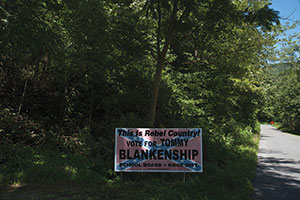
In word and in deed, Blankenship made it crystal clear to his underlings what their priorities should be. The Massey chief often gave his managers cans of Dad’s Root Beer, not to quench their thirst, but to send a message: At Massey, Blankenship later explained in a deposition, Dad’s was short for “Do As Don Says.” Lest there be any confusion about the importance of his instructions, phone calls from the chief executive—who demanded updates from his mine supervisors every half hour—came in over an actual red phone.
“It’s impossible for me to suggest that there is any more pressure that could be brought to bear, except with a Roman whip, than with what Don Blankenship did every 30 minutes,” says Davitt McAteer, a former MSHA inspector who managed the state’s investigation of the Upper Big Branch disaster. “If you don’t think that gets to a man’s mind, you’re crazy.”
Upper Big Branch was the biggest catastrophe during Blankenship’s tenure, but it wasn’t the first. In the decade after Massey went public in 2000 with Blankenship at the helm, there were 54 fatalities at its mines, a dismal safety record that set the company apart from its competitors. Of those accidents, the one that offered the clearest warning of what was to come occurred in 2006 at a southern West Virginia site called the Aracoma Alma Mine No. 1. The facility bore several similarities to Upper Big Branch. Workers sometimes operated in flooded conditions and amid excessive amounts of combustible dust. They were under enormous pressure to produce. And they had no UMWA presence to press for safety improvements.
That January, a fire broke out in an underground storage unit. This was a common risk (it had happened before at Aracoma), which is why federal regulations require mines to adhere to strict fire safety codes. But the sprinklers didn’t work. Neither did one of the fire alarms. A carbon monoxide alarm hadn’t been installed. The emergency exits weren’t marked. And structures that would have contained the smoke within a confined area had been removed. After miners evacuated the chamber, 28 minutes passed before the rest of the mine was alerted. Meanwhile, the smoke spread to the designated escape passage. Two miners died when they were unable to flee fast enough. An Aracoma Coal Co. employee later testified that in his entire time at Alma Mine No. 1, the company never conducted a single fire drill.
In its official report on the fire, the MSHA detailed how Massey’s disregard for safety violations resulted in the tragedy: “In each case, no effective management system, policy or procedure was in place to assure compliance with the underlying regulations and safe mining practices,” the report declared. Included was a memo from Blankenship himself, directing all deep-mine superintendents to put aside safety projects and focus on moving product. “If any of you have been asked by your group presidents, your supervisors, engineers or anyone else to do anything other than run coal (i.e.—build [ventilation] overcasts, do construction jobs, or whatever), you need to ignore them and run coal,” he wrote. “This memo is necessary only because we seem not to understand that coal pays the bills.” (Soon thereafter, Blankenship circulated a memo emphasizing Massey’s commitment to safety.) Aracoma pleaded guilty to 10 criminal charges of mine safety violations in federal court and paid a $2.5 million fine. It also paid $1.7 million in civil penalties to the MSHA for “reckless disregard” of mine safety. Four Aracoma foremen pleaded guilty to misdemeanor charges, but a plea agreement prevented the Department of Justice from seeking charges against anyone at Massey. Blankenship, for his part, told a conservative talk show host that the miners probably died because they “panicked.”
The company took the same cavalier approach to environmental regulations. In 2000, a 72-acre reservoir of coal mining sludge flooded the town of Inez, just across the river from Mingo in Martin County, Kentucky.* Massey had built the reservoir above one of its abandoned mines. The muck flowed into the mine and from there into a tributary of the Tug Fork River. The resulting spill caused $58 million in damage, making it one of the largest environmental disasters in US history. Residents of 10 Kentucky counties temporarily lost access to drinking water. Even closer to home, 769 Mingo County residents filed lawsuits between 2004 and 2009 alleging that Rawl Sales contaminated their water supply by injecting 1.4 billion gallons of coal waste into abandoned mines during Blankenship’s tenure there. The company denied any wrongdoing, but during a deposition Blankenship admitted that he’d installed his own water line, which connected his house to a town farther removed from the alleged areas of contamination. (The company settled for $35 million in 2011 and dedicated $5 million to monitor health consequences in the affected communities.)
Even as Massey polluted the environment and exploited its employees, Blankenship cast himself as the true savior of West Virginia workers, who he claimed were being stifled by radical environmentalists perpetuating the hoax of climate change and by government bureaucrats imposing job-killing regulations. Increasingly he entered the political fray, spending millions to promote his anti-government philosophy. In 2005, he channeled $650,000 into a successful campaign to defeat a referendum, favored by Democratic Gov. Joe Manchin, to issue bonds to fund public employee pensions. Later that year, he dumped $500,000 into ads pressuring the Legislature to repeal the state’s 6 percent food tax, on the theory that tax cuts would stimulate economic growth while shrinking the size of government. (The state Legislature reduced the tax to 5 percent.) And in 2006, he spent $1.8 million backing 41 Republican candidates for state offices. Only one of them was successful—and in that case the Democratic incumbent was in a nursing home. But poor white voters, egged on by business tycoons like Blankenship, were beginning to see government as the source of their problems.
In 2009, seven months before the Upper Big Branch disaster, Blankenship decided to hold a Labor Day rally on the site of a surface mine near Mingo. Billed as the “Rally for American Workers,” the event was a bit of counterprogramming to the annual blowout organized by the UMWA. Headlined by conservative luminaries including Sean Hannity, Nugent, and Hank Williams Jr., Blankenship’s rally drew 75,000 people. “Washington and state politicians have no idea how to improve miner safety,” he told the crowd. “The very idea that they care more about coal miner safety than we do is as silly as global warming.” For the occasion, Blankenship wore an American flag hat and an American flag shirt. When an attendee asked him to run for president, he cracked a wide grin. “We pay Turkey $30 million a year just to land our airplanes,” he added, in a fit of populism, “but we can’t find enough money in this country to have clean water and sewage in Appalachia.”
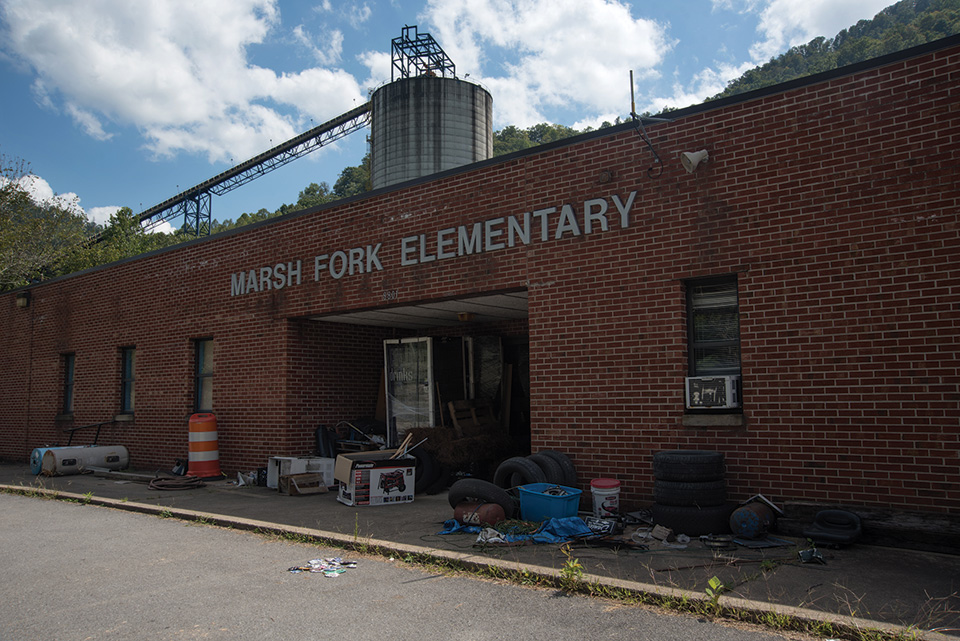
To see firsthand Blankenship’s footprint on southern West Virginia, I caught a ride one afternoon in August with Vernon Haltom, a barrel-chested Lebowski of a man in a Johnny Cash shirt who runs an anti-surface-mining group called Coal River Mountain Watch. Massey didn’t invent the practice of mountaintop removal—flattening mountains to access the coal within them—but the company became Central Appalachia’s largest coal producer by mastering it. From atop a former surface mine site, we could see an active mountaintop project being undertaken by Alpha Natural Resources, the company that bought Massey. While we watched, the scarred plateau belched a plume of dust from a controlled blast.
Cruising past overloaded coal trucks in his SUV, Haltom slowed to point out hamlets with names like Twilight and Lindytown that had been wiped out by Massey’s expansion and turned into “valley-fills”—dumping grounds for mining debris. The signs of depopulation were everywhere: a shuttered library and state police station, a park where a high school once sat, and vacated main streets. Down the road from Upper Big Branch, a memorial funded in part by Alpha touted the job-creating legacy of the coal industry. By a back entrance to the now-shuttered mine was a more informal installation—29 hard hats and two mourning angels. Their wings were solar powered.
We pulled over outside the old Marsh Fork elementary school, which closed in 2012. The site was overgrown, with six-foot-high grass along the basketball court, but my eyes immediately gravitated to what sat above it: a massive silo, where processed coal was once loaded onto train cars to be taken to market. Nearby was an open-air sludge dam (much like the one that burst near Mingo) containing 2.8 billion gallons of waste. The nearest surface mine was five minutes away, and every afternoon around 4 p.m., a faint rumble echoed down into the hollow from the blasting. Before it closed, the school was perpetually coated in a thin layer of dust; air-conditioning filters would come out black. A 2005 survey by Haltom’s group found that 80 percent of the area’s children had respiratory problems.
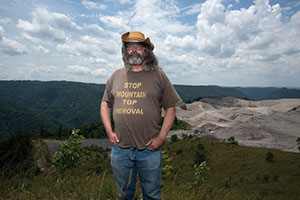
That year, Blankenship applied for a permit to construct a second silo on the site. Although the project was initially green-lit, Gov. Manchin, who is now a US senator, asked the state’s environmental agency to give it a second look. The state ultimately blocked the plan. Blankenship went on the warpath, relying on Massey’s usual method of bludgeoning its opponents into submission—litigation. Massey appealed the state’s ruling on the silo, and Blankenship personally fired back with a lawsuit against Manchin, alleging he was being punished for past statements critical of the governor. Blankenship and Massey also sued the Charleston Gazette, the UMWA, and a political group called West Virginia Consumers for Justice for $300 million, alleging they had conspired to defame the CEO and his company by airing critical information. A judge dismissed the lawsuit but the Marsh Fork silo case headed to the state Supreme Court, along with another artifact of Massey’s strong-arming ways—Hugh Caperton’s 1998 lawsuit stemming from the bankruptcy of Harman Mining.
After Caperton won a $50 million judgment in 2002, Massey had appealed the case to the state Supreme Court. In preparation for the appeal, Blankenship decided the court needed an overhaul. In early 2004, ahead of the state’s judicial elections, he met with an upstart Republican lawyer, Brent Benjamin, and promised his support against the liberal incumbent. Benjamin was a comparative unknown in West Virginia, where a Republican hadn’t been elected to the state Supreme Court since 1928, but Blankenship had a plan. He poured $3 million into a campaign fund that ran ads tarring the Democratic justice as soft on child molesters. It was an unprecedented expenditure by a single donor, and it worked: Benjamin narrowly beat his opponent.
When the state Supreme Court heard the Caperton case in 2007, Massey won a big victory—with Benjamin voting in its favor. Then, in early 2008, the Charleston Gazette published photographs of Blankenship on the French Riviera with an old friend from Mingo County—Spike Maynard, now also a state Supreme Court justice, who had cast another of the three votes in favor of Massey. In 2009, in a landmark decision, the US Supreme Court granted Caperton another chance, ruling that Benjamin should have recused himself; $3 million in campaign donations from a defendant with business before the court constituted a clear conflict of interest. But even with his two favorite justices sitting out the case, Blankenship won the final appeal on the grounds that it should have been tried originally in Virginia (where Caperton’s company was headquartered). When he brought the case there, Caperton eventually won a $4 million judgment, a fraction of what Massey once owed him.
Blankenship also won the right to build a second silo above Marsh Fork elementary. When the cash-strapped school district considered asking Massey for help relocating, a company spokesman suggested that it already paid enough in annual taxes. Only after the late Sen. Robert Byrd excoriated the company for its “disregard for human life and safety” did it chip in $1 million toward a new building farther down the valley.
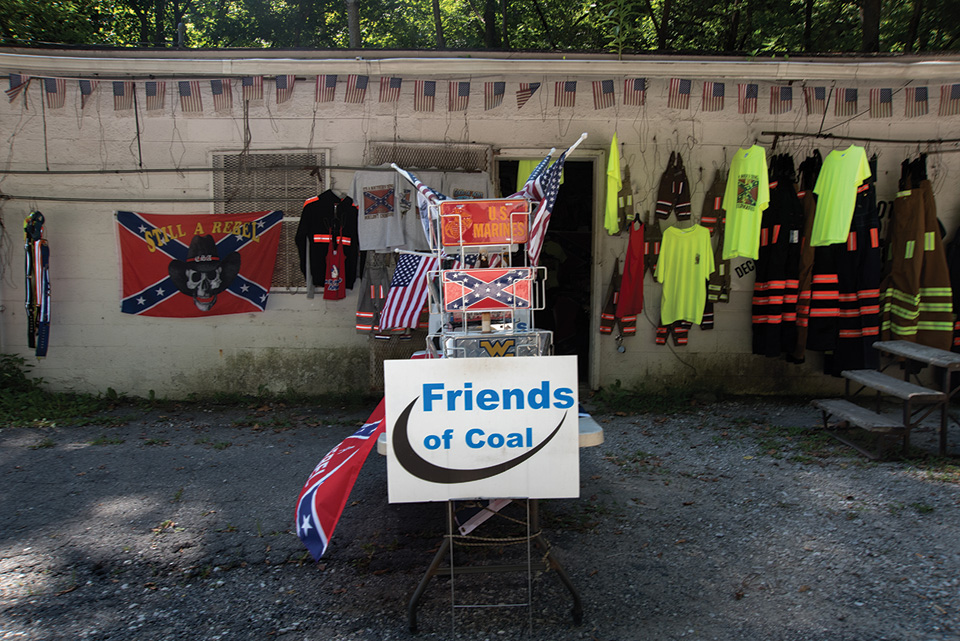
At upper big branch, miners labored amid thick layers of coal dust and in chest-high water while dodging debris from the crumbling ceiling. In the year preceding the explosion, inspectors shut down portions of the mine for safety violations 48 times—a rate nearly 19 times the national average. “I’m just scared to death to go to work because I’m just scared to death something bad is going to happen,” one miner confessed to a friend, shortly before he was killed in the blast. But Upper Big Branch was a cash cow. In 2009, the mine generated $331 million, 14 percent of the company’s overall revenue. Massey repeatedly delayed necessary improvements to the mine’s safety system for the sake of moving more and more coal.
The day after Easter in 2010, a piece of metal shearing equipment scraped against the mine’s sandstone wall, causing a spark that ignited a pocket of gas, which created a fireball that gained intensity as it gorged on the thick coating of coal dust. As at Aracoma’s Alma Mine, a standard fire safety implement—in this case, the shearing machine’s water spray system, which is designed to prevent sparks from igniting—wasn’t functional. The flames spread more than a mile in minutes. No one in the mine stood a chance. An incident report compiled at the direction of Manchin characterized the explosion as the product of a “perfect storm,” made of “insufficient air, a build-up of methane and enough coal dust to carry an explosion long distances through the mine.” Independent state and federal investigations each blamed the company for creating those conditions.
As the evidence piled up of Upper Big Branch’s dangerous atmosphere, Blankenship remained defiant. “The politicians will tell you we’re going to do something so this never happens again,” he said. “You won’t hear me say that, because I believe that the physics of natural law and God trump whatever man tries to do. Whether you get earthquakes underground, whether you get broken floors, whether you get gas inundations, whether you get roof falls—oftentimes they are unavoidable, just as other accidents are in society.”
Even someone of his bombast would have struggled to maintain control of a publicly traded company after that, and although Blankenship held onto his job for another eight months, he resigned in late 2010 after running up a seven-figure loss in his final quarter. He walked away with an $86 million golden parachute—including a $10.9 million salary, $14.4 million in severance, an office and a secretary for five years, his primary estate in Mingo County, and a 1965 Chevy truck. Massey kept the mountaintop mansion.
Cast adrift, Blankenship tried to anoint himself a political martyr. He launched SaveTheCountry.com and started publishing his correspondence with members of Congress and public officials, along with screeds on assorted topics. They were the rants of a man with too much free time and money and no one to tell him to stop. “He is not a ‘member’ of America,” he wrote of President “Hussein Obama” in a representative essay. “Mao Tse-tung was President of China at the time Obama was growing up in Indonesia. Mao was undertaking the Chinese cultural revolution wherein the government took everything the upper 1% had and gave it to the poor. Does that sound familiar?”
Blankenship funded and starred in a low-quality documentary on the global warming hoax—Regcession: How the epa Is Destroying America—and then another film, dedicated to his alternative theory of what happened at Upper Big Branch, that he paid to televise on the state’s Fox affiliate. In his telling, the MSHA forced Massey to implement a faulty ventilation plan, which allowed gas to seep into the mine from an underground seam; the whole thing had nothing to do with coal dust. He even signed papers to form a new company, the McCoy Coal Group. But for now, the company exists in name alone.
“He lived by dollars and cents,” says the AFL-CIO’s Trumka, one of many Blankenship foes who has savored the coal baron’s fall from power. “He thought he could buy anything, but the one thing he couldn’t buy was gravity.”
The government’s case against Blankenship includes internal memos, secret recordings, and an achingly long list of violations that might have spared dozens of lives had they not been ignored. But it hinges on personality. Don Blankenship was a tremendous asshole, the indictment seems to say—and Massey’s entire operation was a mirror reflection of his image. His abrasive, dominating persona was perhaps best captured in a story that Nyden, the longtime Charleston Gazette scribe, told me. Blankenship had invited a group of executives to his mountaintop mansion for dinner. He’d made a fuss about showing off his fine china and utensils, but when it came time to eat, the guests received paper plates and plastic utensils. Blankenship alone ate off the good stuff.
He is a physically imposing man who uses his size to his advantage. When an ABC News producer attempted to film him outside his office in 2008, Blankenship threw the man’s camera to the ground and told him, “If you are going to start taking pictures of me, you’re liable to get shot.” A common observation from those who have interacted with him is that when he gets agitated, he licks his lips “epileptic-like,” says Kevin Thompson, a West Virginia attorney who once deposed Blankenship. “There is kind of a movement in the head, and there’s that tongue thing going on.” It’s almost serpentine. “But what I’m struck by are his dead eyes.”
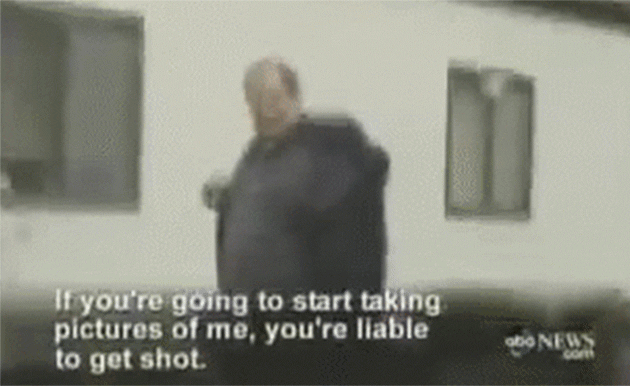
His tyrannical management style extended to his own home. In 2001, a Massey affiliate hired a woman named Deborah May to clean Blankenship’s primary residence, down the street from Mingo County’s only golf course. Blankenship later asked her to clean two Kentucky cabins owned by the company, too. Then he asked her to clean the mountaintop estate. When he acquired a touring bus to travel to his son’s stock-car races, Blankenship expected May to clean that. When the CEO, concerned about his personal security, purchased a German shepherd attack dog and instructed May to take care of it, she quit. By that point, she was working more than 70 hours a week and was making just $8.86 an hour. During the four years she worked for Blankenship, he increased her wage by 30 cents.
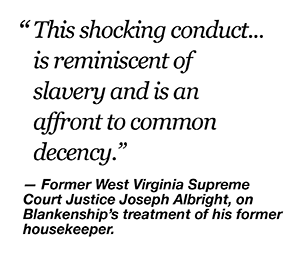
“What I ought to do is take you…out and stone you to death,” she claimed he told her once, after discovering stains on his carpet. On a separate occasion, May alleged, he berated her for forgetting to leave a hanger on his bed for his jacket, ripped the coatrack out of the wall, and demanded she fix it. At another point, she claimed, he harshly reprimanded her for bringing him a McDonald’s bacon, egg, and cheese biscuit—he’d requested egg-and-cheese. “I want you to do exactly what I tell you to do and nothing more and nothing less,” he snarled, according to May. When she forgot to restock his freezer with ice cream, he forced her to write a letter explaining her actions. May couldn’t handle the stress any longer. “You have crushed me,” she told Blankenship in her resignation letter. When she applied for unemployment in Mingo County, she was rebuked. Only after taking her case to the state Supreme Court in 2008 did she receive her benefits. “Such conduct by an employer,” one justice wrote of Blankenship in an opinion concurring with the ruling that May should receive unemployment, “is reminiscent of slavery and is an affront to common decency.” (Blankenship’s pal Maynard recused himself from the case.)
Blankenship was not, in other words, the kind of boss you ignore. Nor was he the kind of boss who would ever let you forget he was there, looking over your shoulder, watching your every move. But the attention to detail that made Blankenship such an effective bean counter may also be his undoing. He constantly monitored every inch of his operation and wrote memos instructing subordinates to move coal at all costs. “I could Krushchev you,” he warned in a handwritten memo to one Massey official whose facilities Blankenship thought were underperforming. He called another mine manager “literally crazy” and “ridiculous” for devoting too many of his miners to safety projects. Despite repeated citations by the MSHA, Blankenship instructed Massey executives to postpone safety improvements: “We’ll worry about ventilation or other issues at an appropriate time. Now is not the time.” And this is only what investigators gleaned from the documents they could find: Hughie Stover, Blankenship’s bodyguard and personal driver—and the head of security at Upper Big Branch—ordered a subordinate to destroy thousands of pages of documents, while the government’s investigation was ongoing. (Stover was sentenced to three years in prison in 2012 for lying to federal investigators and attempting to destroy evidence.)
In a Nixonian twist, according to court records, Blankenship also recorded conversations with Massey executives in which he discussed his mines’ perilous conditions. Even he worried the company was taking things too far. “Sometimes I’m torn with what I see about the craziness we do,” he told then-Massey chief operating officer Chris Adkins in a recorded conversation in November 2009. “I know MSHA is bad, but I tell you what, we do some dumb things. I don’t know what we’d do if we didn’t have them. Maybe if it weren’t for MSHA, we’d blow ourselves up.”
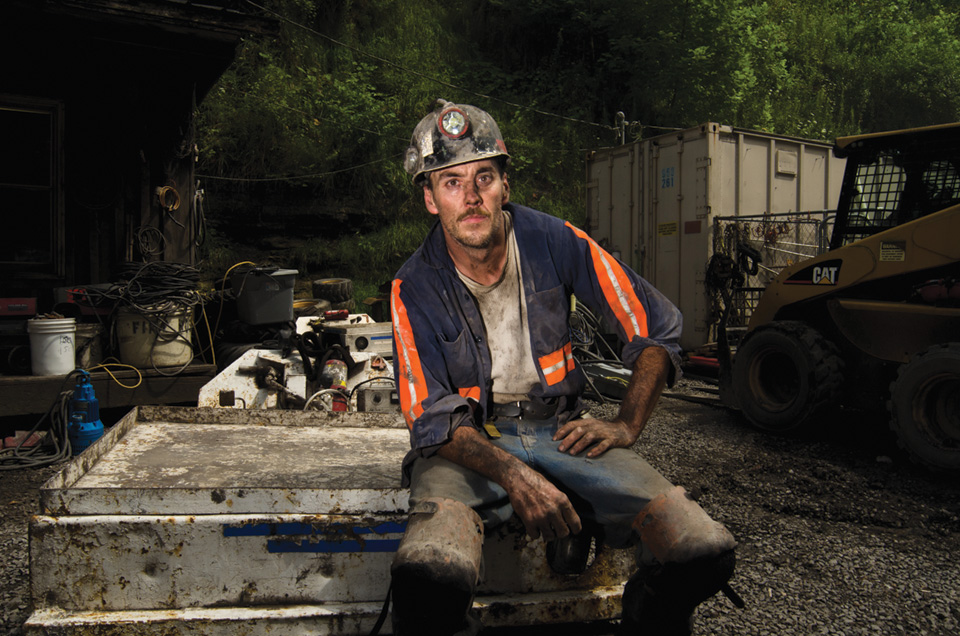
But at the same time, he was allegedly plotting ways to get around the MSHA’s mandates. According to a class-action complaint, when an inspector showed up unannounced at a Massey property, an employee in the guardhouse would use the phone system to tell workers in different parts of the mine that a “load of cinder blocks” had arrived, or that “it’s cloudy outside.” Sometimes the guard would abandon the pretense altogether and simply say, “We’ve got a man on the property.” This was the cue to hang up ventilation curtains and sweep away coal dust. Upper Big Branch had a radio channel—manned by Stover and called “Montcoal”—that was used to evade the MSHA. The indictment alleges that Blankenship encouraged workers to dodge inspectors.
All but one of the charges he faces, a pattern of violation that the UMWA dubbed “industrial homicide,” carry light sentences, adding up to a maximum of six years in prison. What threatens to put the 65-year-old away for decades are two allegedly false statements Massey submitted in a filing with the Securities and Exchange Commission: “We do not condone any violation of MSHA regulations,” and “we strive to be in compliance with all regulations at all times,” Blankenship informed investors, even as his company was allegedly outflanking the regulatory system. It’s the mining equivalent of busting Al Capone for tax evasion.
“I have all the respect in hell that at least somebody was able to say, ‘Wait a minute, that isn’t right,'” says Bruce Stanley, who represented Caperton in his suit against Massey. “But he’s up for what, a possible 30-year sentence? Well, there’s only one count that puts that kind of mileage on it. That’s the one that says he lied to Wall Street. When it comes to human lives, he gets maybe a year.”
Blankenship has hired William Taylor III, the same power lawyer who represented the officials in the Salt Lake City Olympics vote-buying scandal as well as Dominique Strauss-Kahn, the former International Monetary Fund managing director accused of raping a hotel maid—all of whom escaped conviction. His legal team has battled to move the trial out of West Virginia. (The trial was eventually moved from Beckley, the closest courthouse to Upper Big Branch, to Charleston.) They have even pushed to block the Upper Big Branch disaster from being discussed in the trial, on the grounds that doing so would unfairly hold Blankenship responsible for the deaths of 29 miners. Blankenship declined to be interviewed for this story, and in response to a series of questions about the allegations, Taylor offered only a blunt statement: “Donald Blankenship is entirely innocent.”
Blankenship, no stranger to legal clashes, is undoubtedly spoiling for a fight.
“I just can’t see him pleading,” Thompson says. “It’s not in his nature. And I hope he doesn’t, because it would kind of diminish his stature in my mind if he pled. He stuck with his guns so long, he’s almost a cartoon character by now—just an unabashed villain…I hope he keeps going, because I think the jury, the judge—everybody—will throw him under the jail if given the chance.”
The Blankenship indictment is part of an unusually aggressive campaign by West Virginia’s US attorney, Booth Goodwin, a politically connected lawyer with ties to prominent Republicans and Democrats in state government. In August, after an investigation by Goodwin, the president of Freedom Industries, a chemical company whose 2014 spill forced 300,000 West Virginians to buy bottled water, pleaded guilty to violating the Clean Water Act; he was sentenced, along with five of his employees, to a minimum of 30 days in prison. Before indicting Blankenship, Goodwin all but overthrew the Mingo County political establishment that had coddled the coal baron. The county circuit judge who replaced Maynard when he moved to the state Supreme Court, also an acquaintance of Blankenship’s, was sent to federal prison for his role in a prescription-drug ring. So were the county prosecutor and a county commissioner. The county sheriff was accused of being part of the ring, too, though he was murdered in an unrelated incident before he could be prosecuted.
But even Goodwin’s high-profile prosecutions have done little to change the status quo in West Virginia that Blankenship and fellow industry executives spent so mightily to preserve. The state’s signature mine safety accomplishment following Upper Big Branch was a new regulation mandating drug tests for miners, a reform favored by companies and opposed by unions. (Drug use has never been associated with the disaster.) Other reforms have since been rolled back. Federal legislation that would have made it a felony to conspire to commit mine safety violations—what Blankenship is charged with—stalled in Congress thanks to heavy lobbying from the energy industry. Even the chemical safety measure passed by the state Legislature after the Freedom Industries spill was almost immediately gutted by West Virginia lawmakers.
Meanwhile, the state’s once-moribund Republican Party, which Blankenship’s largesse helped kick-start, is taking over. Democratic Rep. Nick Rahall, a mine safety advocate and union supporter who had targeted Blankenship, lost his seat by 10 points in 2014. Last year, Republicans took over the state Legislature for the first time since before the New Deal. They owed some of their success to a flood of dark money—much of it, according to bankruptcy filings, from Alpha Natural Resources—that painted pro-coal Democrats as not pro-coal enough. Near the top of conservative groups’ wish list: so-called right-to-work legislation that would finish off the UMWA in southern West Virginia once and for all. Even as companies such as Alpha and Patriot Coal are declaring bankruptcy, and as the number of coal miners in the state—union or not—plummets, West Virginia’s remaining coal barons have managed to consolidate even more power than they had before.
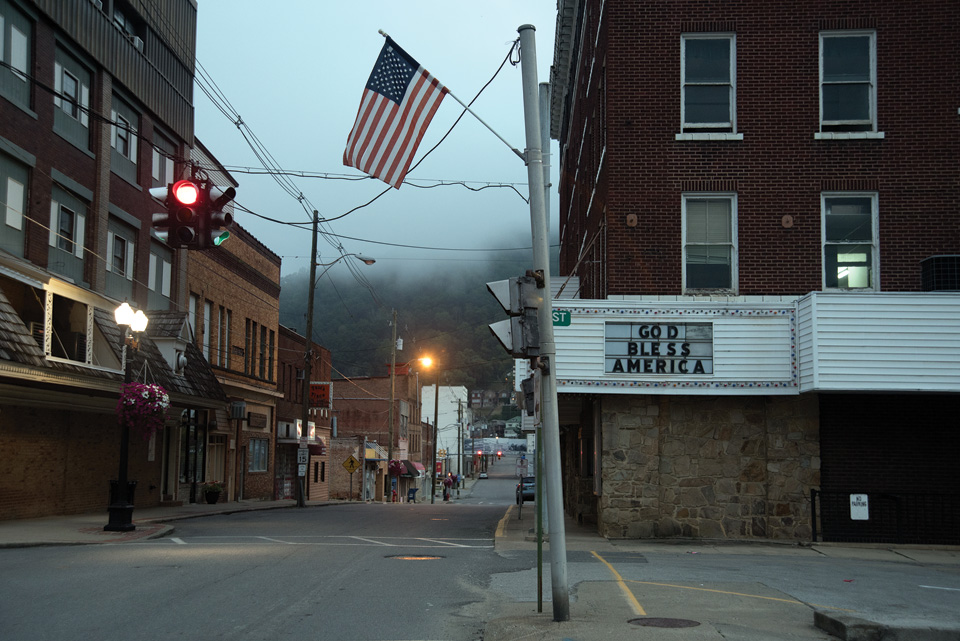
To get to Matewan from the nearest interstate, you drive 82 miles on the Robert C. Byrd Freeway to Williamson, Mingo’s county seat, and then 14 miles more on a winding patch of road that narrows to one lane in several places where the asphalt has collapsed into the valley below. Blankenship’s primary mansion, just past a bait shop, is out of sight but hard to miss. Behind high iron gates and hedges that wouldn’t be out of place in Palm Beach, you can just make out the grand green-and-white complex, with a helicopter pad and a large garage.
Downtown Matewan is a small place, hemmed in by floodwalls engraved with scenes of gunfights and toiling miners. When I inquired at the library about some old high school yearbooks, the librarian apologized and said they had none, but she pointed me toward the post office and told me to talk to a woman there named Crystal, who could put me in touch with Blankenship’s daughter, Jennifer, who runs the mail route for the town. I never heard from Jennifer, but the next day I met a man named Elmer Hatfield, a painter who is a member of the illustrious clan, and he told me that he’d heard from Blankenship’s son-in-law that I was working on a story. News travels fast.
Blankenship’s presence is felt everywhere. Across from the historic downtown, at a reconstructed railroad depot—built with funding from Massey—a placard invites visitors to stop by a nearby diner, where you might find Blankenship and “shake him down” for a free lunch. The diner is now closed. So is Blankenship’s alma mater, Matewan High, where E. Morgan Massey once built a football field in exchange for the right to store coal waste beneath it. Matewan students now take a bus on King Coal Highway to a new county school, built on a former surface mine. (Its mascot is the Miners.)
When a coalition of state and local groups, including the UMWA local chapter, opened the West Virginia Mine Wars Museum in Matewan last May, Blankenship got curious and popped in. It’s a small space, but with a rich collection of artifacts from the industry’s bloody past. A UMWA ballot from 1982 that presaged Trumka’s showdown with Rawl Sales sits by the front entrance, near a poster advertising a visit to Matewan by Mary Harris Jones weeks before the massacre. Coal executives and their allies do not come off well in the exhibits. The indicted tycoon took it all in during his visit, and then he sat down and talked for a while with a docent, waxing nostalgic about the heyday of coal-company baseball leagues, when each mine fielded its own nine. A proud student of the game, he rattled off pitchers from 60-year-old company squads as if they were Yankees. When Blankenship ran into Wilma Steele, a museum board member and his former high school classmate, he joked that what the venue really needed was mummies—”union mummies.”
“The thing with Don is, can you imagine if he’d been hired by the West Virginia treasury department?” says Steele, as we sat in the front of the museum surrounded by artifacts of armed confrontations. “He would’ve just weeded out corruption! He would’ve got things running! He would’ve been a good person.” This is the tragedy of Don Blankenship to his fellow citizens of Mingo County. He could have been seen as the savior he saw himself as. “I hope he comes back to Matewan,” Steele says, sounding almost surprised by her own words. “After he goes to jail. He could do some good.”
*Correction: This piece originally misidentified the county Inez is in.

